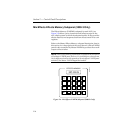
2-30
Section 2 — Control Panel Descriptions
An effects dissolve may be learned into a register, so that recalling
that register will initiate a dissolve to another specified register.
The following button sequence is used to learn a dissolve
(parameters in parentheses are optional):
LRN, EFF DIS, (TRAN RATE, eff dissolve rate), register
NOTE:
LRN
and
EFF DIS
may be pressed in either order to start the
command sequence;
TRAN RATE
enables a user-defined effects dissolve rate to be introduced
in the dissolve;
eff dissolve rate
is a 1- to 3-digit number entered on the keypad that
specifies the effects dissolve rate in number of TV frames. (If the number
entered is a 1- or 2-digit number, the entry must be terminated by
pressing
ENTER
)
;
register
is any desired register number, as described previously (that is,
BANK
,
bank number
,
register number
).
The effects dissolve rate is the same as the auto transition rate
indicated in the readout on the Transition subpanel of that M/E.
When the register with the learned effects dissolve is recalled, the
EFF DIS button high tallies, turning off when the dissolve ends.
Different sequence delays may be learned into the different
mix/effects E-MEMs. With software version 3.1 and later, these
sequence delays are completely independent; thus the sequencing
may be occurring at different times on the different M/Es.
As with sequence delays, the effects dissolve rates on different
mix/effects are completely independent. Different effects dissolve
rates may be learned separately into different mix/effects E-
MEMs; thus the dissolves may be running at different rates on the
different M/Es.
The • (dot button is used to represent the next empty register when
used with the LRN operation. (At register 99, the search for an
empty register will wrap around to 0).
UNDO
•


















